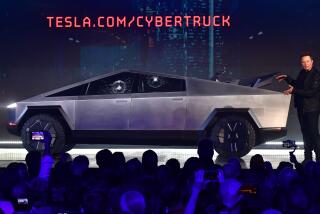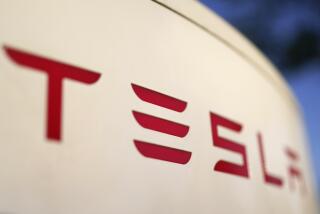Elon Musk claims a million Teslas will drive themselves in a year. Safety advocates have concerns
Tesla, under pressure to show it can generate profits on its main business of making electric cars, on Monday trumpeted a custom-designed computer chip to let its vehicles drive themselves.
Even with the new chip — which comes with all new vehicles and can be installed in older ones — Teslas still aren’t yet fully capable of driving without human intervention. They now have “all hardware necessary,” said Elon Musk, Tesla’s chief executive officer. “All you have to do is improve the software.” The software will be updated over the air to allow full self-driving by the end of the year, he said.
Tesla’s aim is to create a fleet of self-driving cars that can be used as robot taxis in what Musk is calling the “Tesla fleet.” The company will manage the apps and software. Tesla owners could let their cars out for robo-taxi use, with the company keeping a percentage of the revenue. Tesla would also operate its own robo-taxi fleet.
“We expect to deploy the first robo-taxis with no one in them next year,” Musk said Monday. “I’m confident we’ll get regulatory approval somewhere.”
Tesla is one of many automobile manufacturers working on driverless vehicles, capable of driving themselves without a human behind the wheel. Tesla has the most aggressive timeline, aiming to enable its cars to drive themselves on public roads by the end of the year where regulations allow.
That has made Musk a target of other companies that are working on a more cautious path toward autonomous transportation. On Monday, a consortium of auto and tech companies working to improve the industry’s image issued cautions via Twitter:
“Most vehicles available for sale today offer driver assistance features; in all vehicles available for sale today, even those with the most advanced of these aids, the driver must always monitor and be prepared to control the vehicle,” said the Partners for Automated Vehicle Education, or PAVE.
“It is damaging to public discussion about advanced vehicle technologies — and potentially unsafe — to refer to vehicles now available for sale to the public using inaccurate terms. This includes terms such as ‘fully automated,’ ‘full self-driving,’ ‘fully autonomous,’ ‘auto pilot” or ‘driverless,’ which can create an inaccurate impression of vehicle capabilities that can put drivers and other road users at risk.”
Consumer Reports put out a media statement immediately after the Musk event.
“We’ve heard promises of self-driving vehicles being just around the corner from Tesla before,” said David Friedman, vice president of advocacy. “Claims about the company’s driving automation systems and safety are not backed up by the data, and it seems today’s presentations had more to do with investors than consumers’ safety.”
He accused Tesla of “treating the public like guinea pigs.”
Most vehicles available for sale today offer driver assistance features; even those with the most advanced aids require the driver to always monitor and be prepared to control the vehicle.
Investors, who are waiting anxiously for what is expected to be a dismal quarterly earnings report on Wednesday, will be considering whether Musk’s ambitious vision will be translated into profitable products and services.
The new computer chip is positioned behind the glovebox. Most older Teslas can have it installed by a technician. The chips will work with radar, optical and ultrasonic sensors already installed in Tesla cars. Musk said any car built since October 2016 would be capable of full self-driving once it has the new chip.
The chip provides “a new level of safety and autonomy ...without affecting our cost or range,” said Tesla chip designer Peter Bannon. Bannon delivered a highly technical overview to investors gathered at Tesla’s Palo Alto headquarters.
The crowd-sourced, social media swarm that is betting Tesla will crash and burn »
Tesla started developing the computer in 2016, the same year its relationship ended with self-drive chip supplier Mobileye. Since then, it’s been using chips from Nvidia. But Musk said Monday that while Nvidia makes “great chips,” the company has to satisfy large numbers of customers and applications, including video gaming and cryptocurrency mining. The Tesla chip is designed exclusively for self-drive Teslas, Musk said. Tesla contracts out the manufacture of the chip.
Musk faces formidable challenges. Regulations governing autonomous cars remain a state-by-state patchwork with Congress still struggling to enact new federal legislation. Safety concerns are rising as some cars equipped with Tesla’s Autopilot driver-assistance technology have crashed and drawn attention on social media and tech sites. The industry and government have not come up with the basic data and a common, transparent method of assessing the safety of driverless cars, so the general public is left to guess whether new technologies offer improvements over human drivers, and if so, by how much.
Tesla is also controversial in the driverless industry for its decision to forgo expensive lidar sensor technology. Lidar uses light beams to identify physical objects. Most autonomous vehicle developers are using a mix of lidar, radar and visual camera sensors. Musk believes that radar and optical sensors are sufficient by themselves.
“Anyone relying on lidar is doomed,” Musk said Monday. “Lidar is lame. In cars, it’s frigging stupid.” He added that Tesla’s competitors “are all going to dump lidar, is my prediction. Mark my words.”
Tesla’s robo-taxi business model is far from proven. App-based ride-share companies Uber and Lyft have been operating driver fleets for years and now are selling stock to the public. If Tesla leapfrogged those competitors by getting out first with driverless cars, it theoretically could cut costs enough to gain market share. Musk said Tesla has an advantage in the data it is constantly picking up on the road via car sensors, which is wirelessly delivered to company’s developers.
Tesla would need billions to fund such an ambitious project, though. The company, tight on cash, has been cutting back on research and capital expenditures. Several Wall Street analysts say Musk will need to raise billions of new capital, and can’t explain why the company hasn’t done so. Musk has said there’s been no need.
Adam Jonas, analyst at Morgan Stanley, asked Musk on Monday where he would get the money to fund his robo-taxi effort. Musk implied it would be funded out of corporate cash flow, leaving the company “cash flow neutral” until the robo-taxi service is launched. But he didn’t say what kind of cash flow. The implications for profits and free cash flow for this year and next went unstated. (Free cash flow is considered the most important measure of cash flow for a cash-tight company.)
Daniel Ives at Wedbush Securities expects a “train wreck quarter” on Wednesday, with Tesla posting big losses off of stalled sales. Still, he said in a recent investor note, “we firmly believe in the long term vision for Tesla and expect self driving autonomous technology will be the linchpin of the company’s success.”
The range in target prices for Tesla stock is almost bizarre, reflecting wildly different opinions about Tesla’s growth prospects. The stock closed trading Monday at $262.75 a share, down 3.9%.
The Ark Invest money management group sees Tesla trading at $4,000 as self-drive technology becomes more popular. Ives puts an “outperform” rating on Tesla, with a 12-month price target of $365.
At the other end of the spectrum, Garrett Nelson of CFRA recommends Tesla stockholders sell, with a target price of $225 a share. And short sellers have set a target price as low as zero.
Twitter: @russ1mitchell







